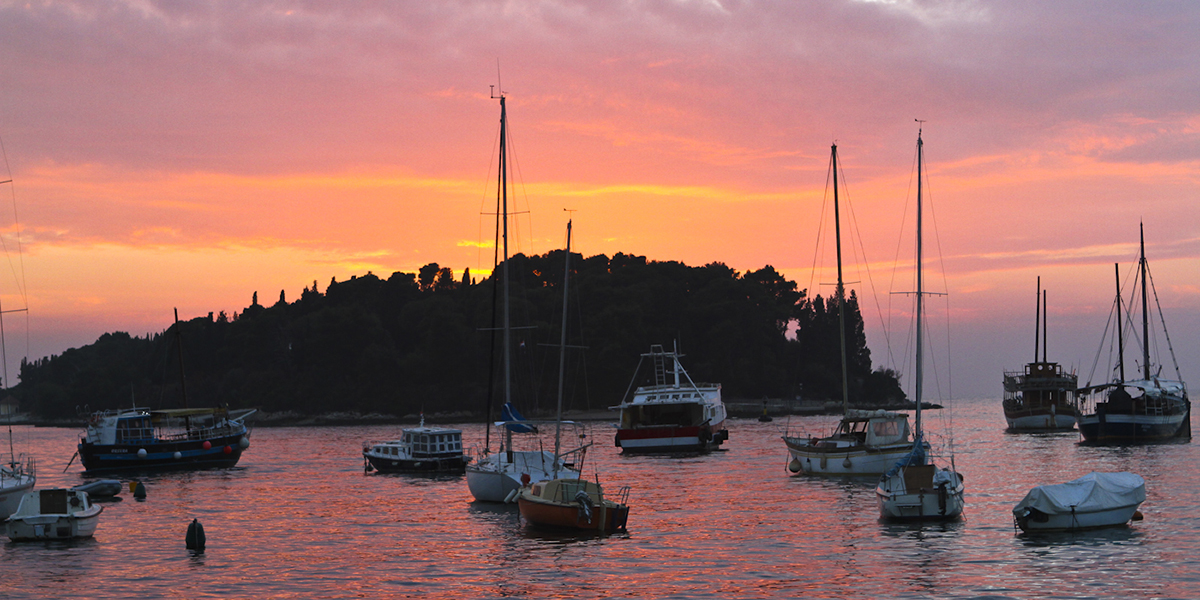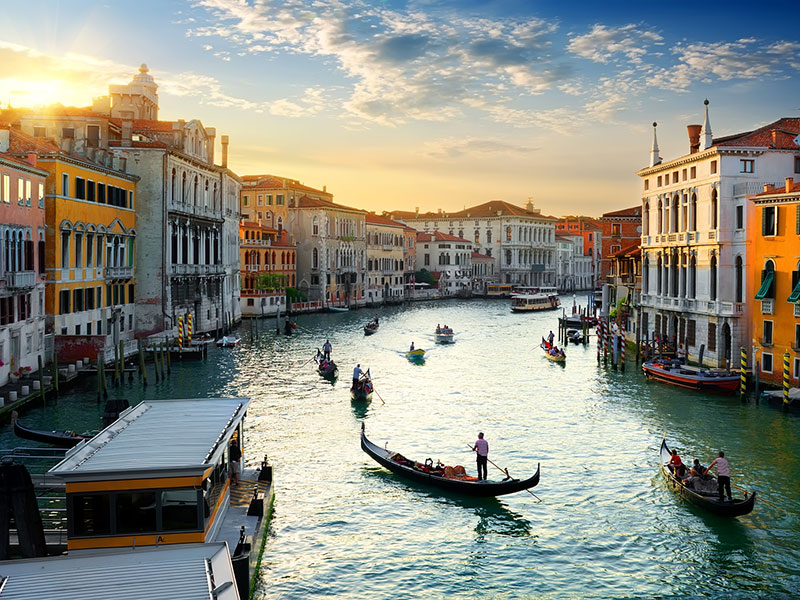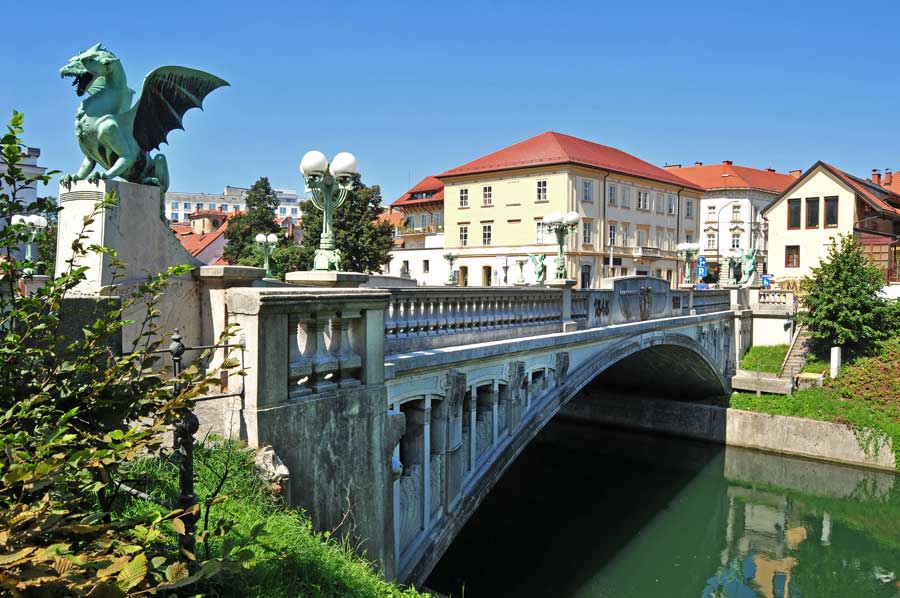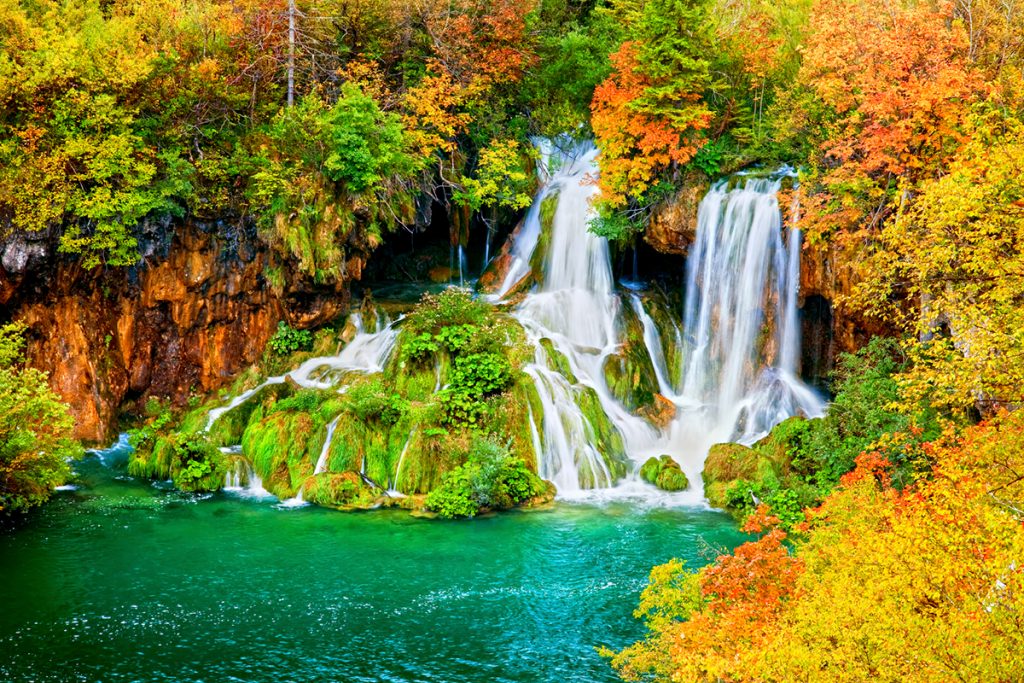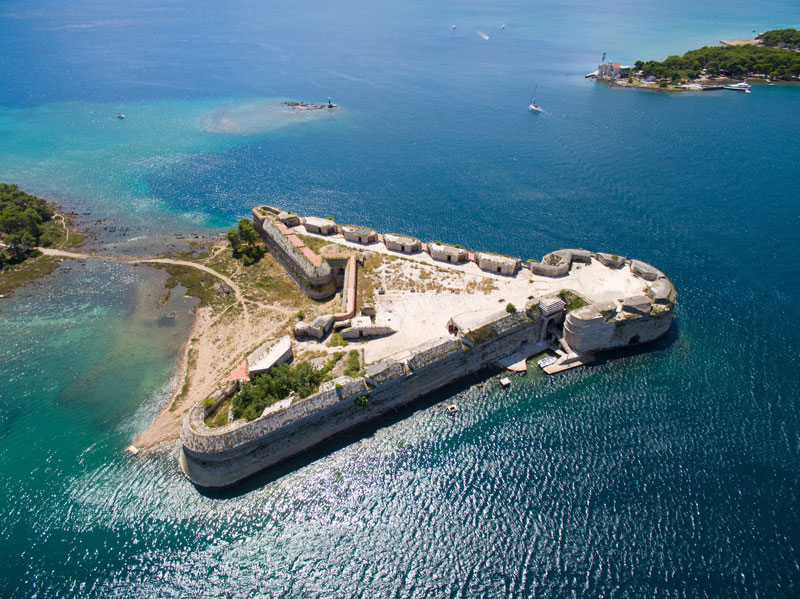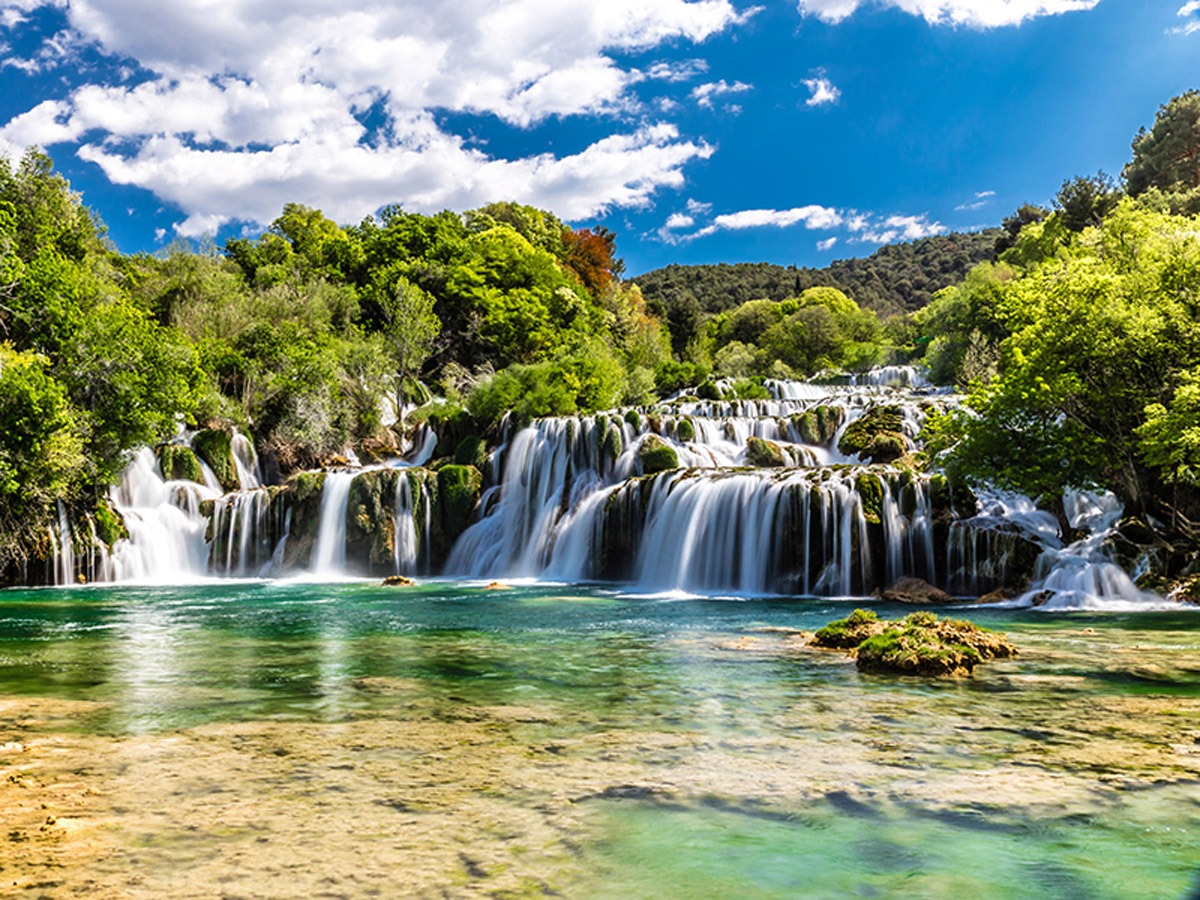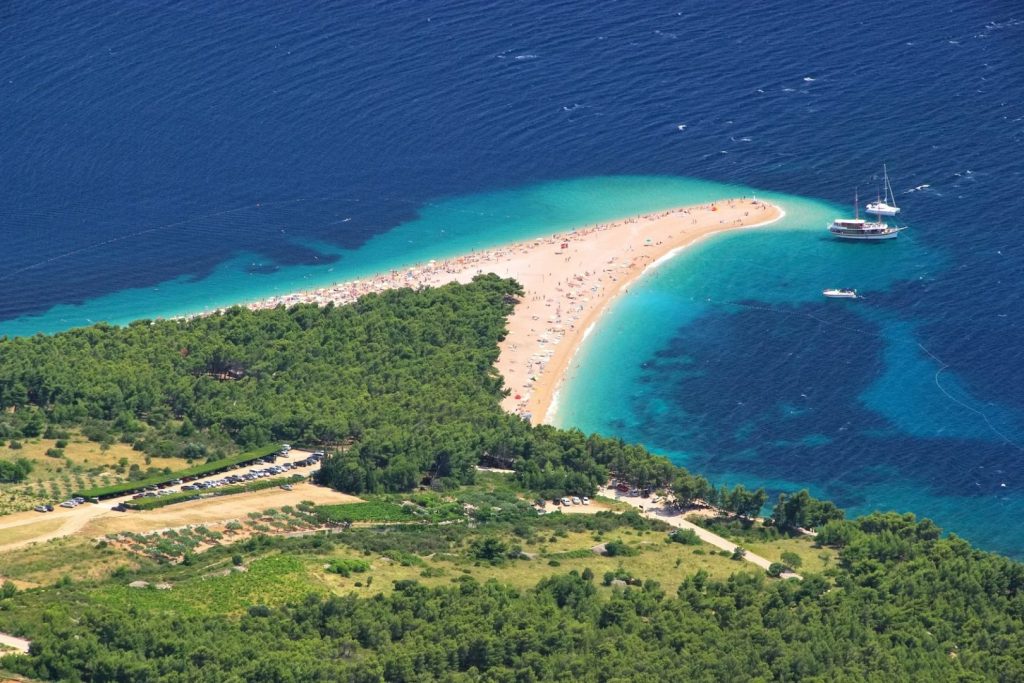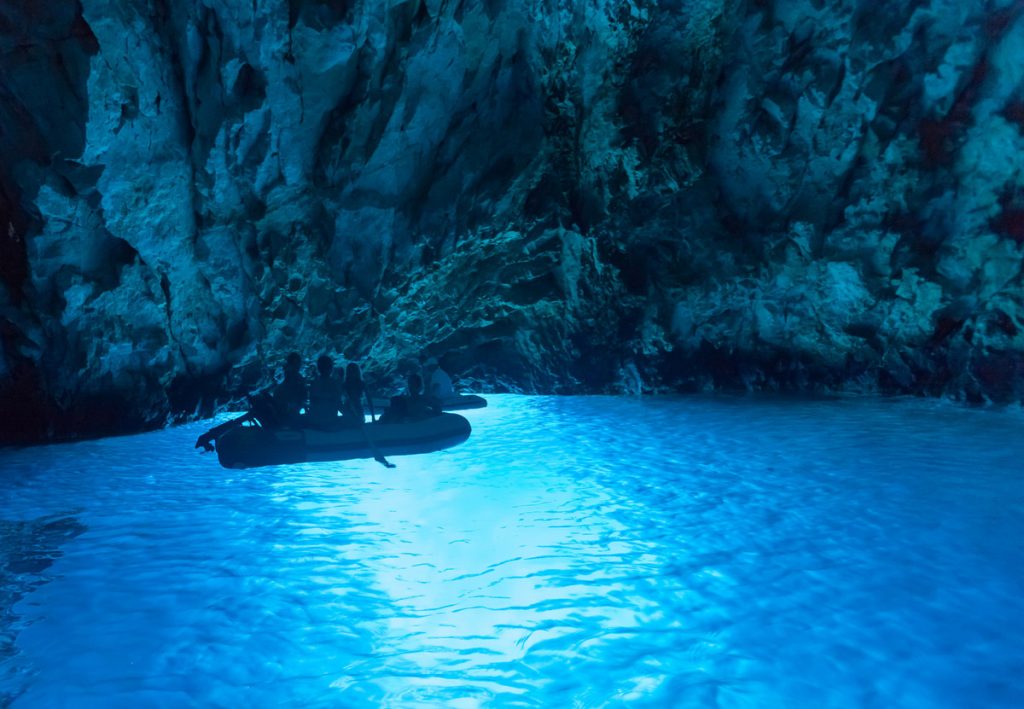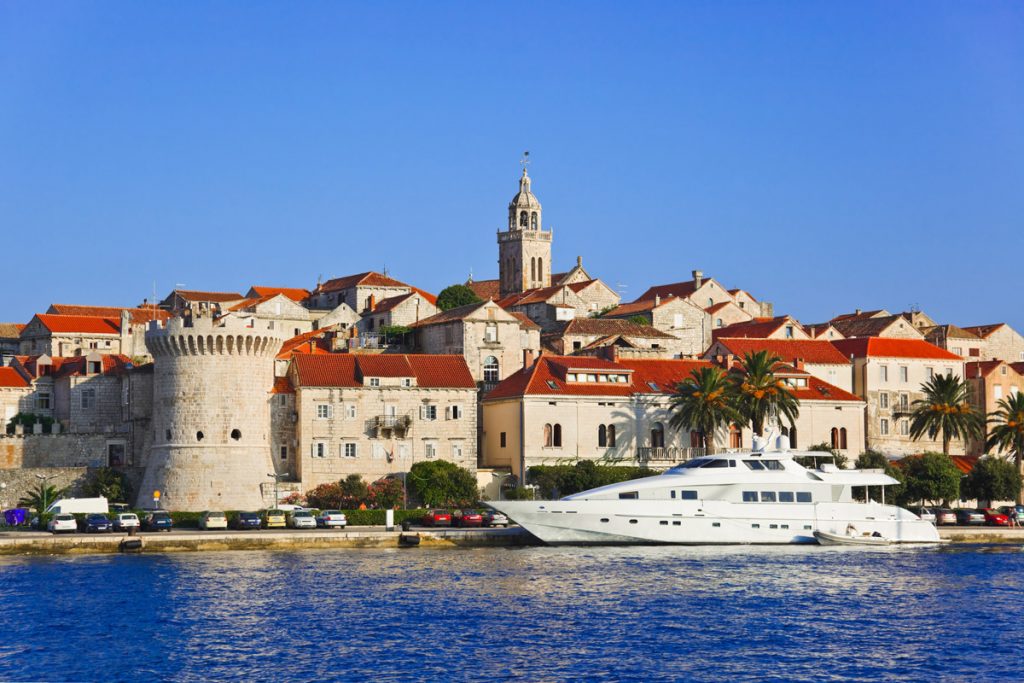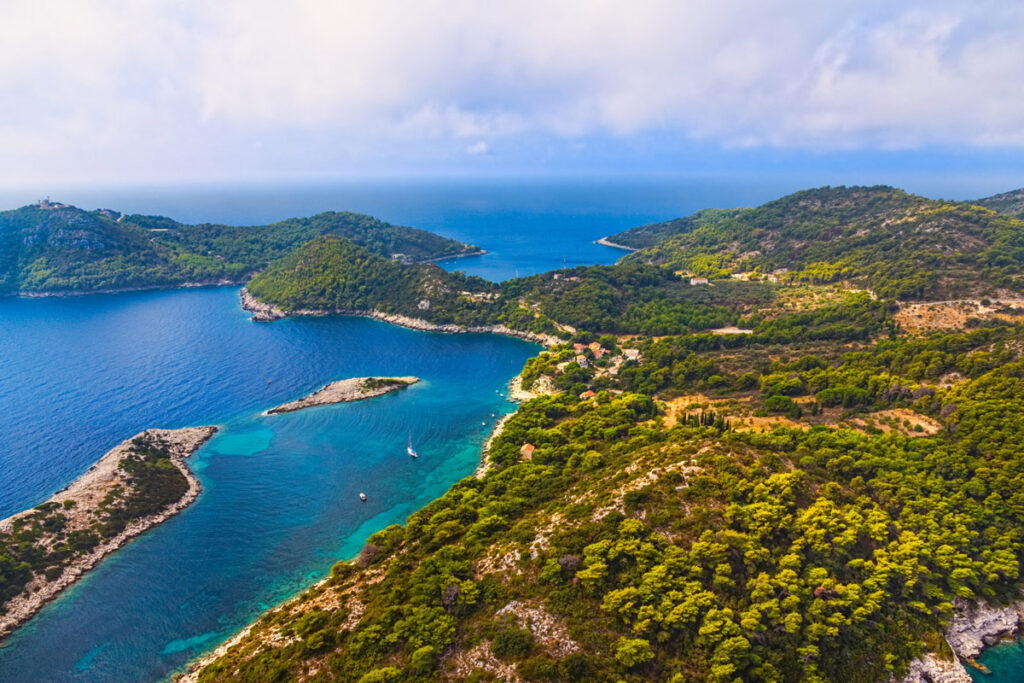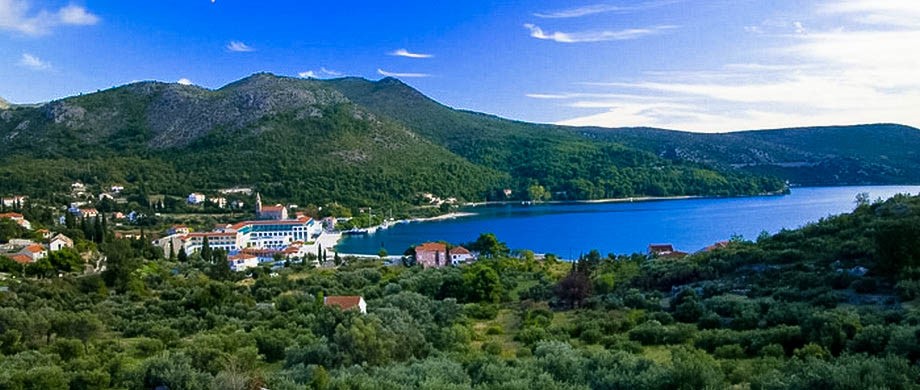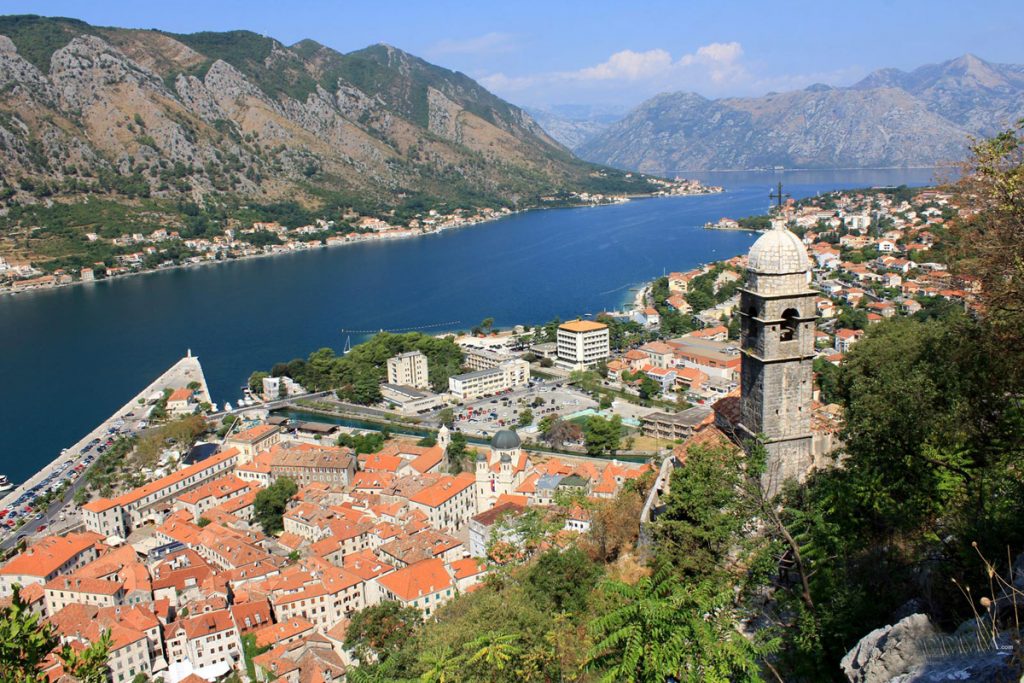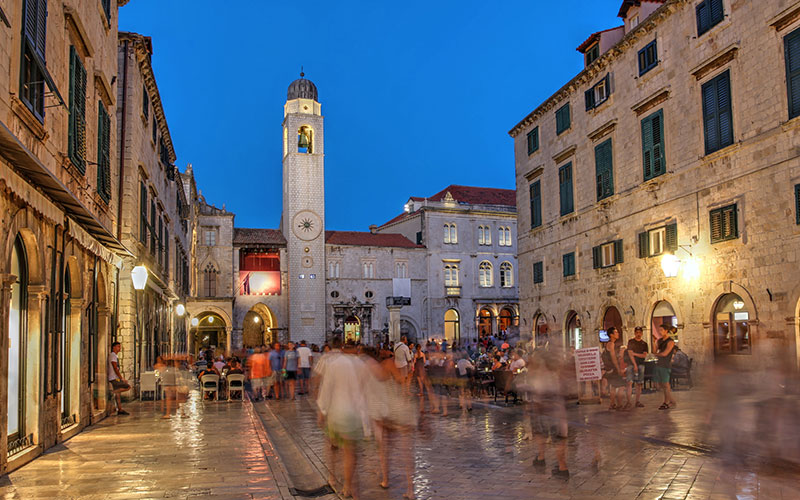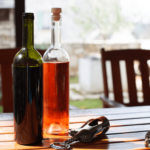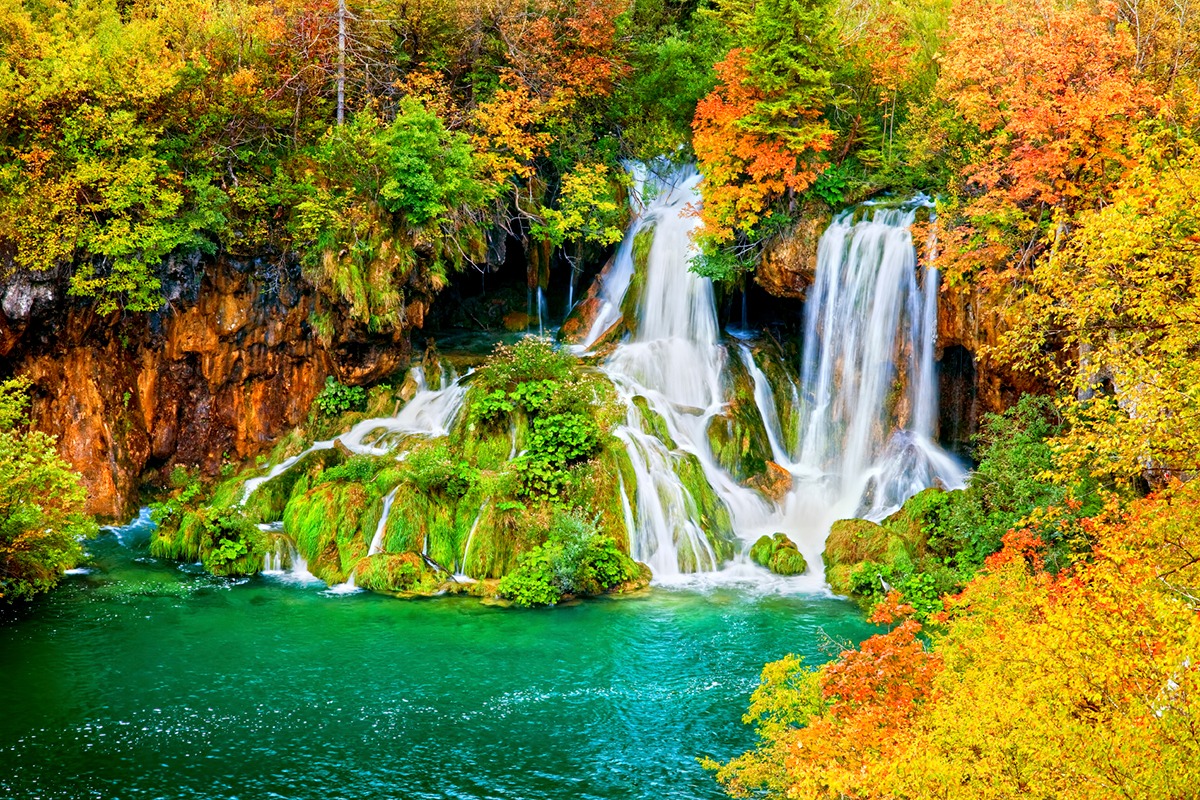
Adriatic Wonders
Visiting: VENICE – TRIESTE – LJUBLJANA – BLED – ZAGREB – PLITVICE LAKES NATIONAL PARK – ZADAR – ŠIBENIK – KRKA NATIONAL PARK– OMIŠ – SPLIT (EMBARK THE CRUISE) – SPLIT – (BOL) HVAR – VIS – KORČULA – MLJET – SLANO/ STON – DUBROVNIK – MONTENEGRO
Visiting Croatia, Slovenia and Montenegro for the first time is a life changing experience. To visit time and again is to re-affirm life. Blessed with magnificent scenery and incredible history and enriched with folk traditions and delicious regional foods and wines, here is a region so divine that it has been named one of the best travel destinations in the world. Mediterranean, European, and Balkan influences have formed an ancient and distinctive culture throughout its pastoral countryside to its shimmering coastlines. Powerful mountain ranges have carved legacies in their midst while fairy tale castles and walled seaside villages stand as a testimony to its tumultuous past. This gorgeous and peaceful land gained independence in 1990’s and beckons passionate travelers from all over the globe. From its lush national parks teeming with flora and fauna and stunning waterfalls to its glistening chain of lavender and citrus scented islands in the sun drenched Adriatic Sea, this is truly one of the most beautiful spots on Earth. A journey to this culturally rich area is a lovely and indelible memory that lives with you forever.
Day 1
VENICE
The UNESCO World Heritage property comprises the city of Venice and its lagoon situated in the Veneto Region of Northeast Italy. Founded in the 5th century AD and spread over 118 small islands, Venice became a major maritime power in the 10th century. The whole city is an extraordinary architectural masterpiece in which even the smallest building contains works by some of the world’s greatest artists such as Giorgione, Titian, Tintoretto, Veronese and others.
In this lagoon covering 50,000 km², nature and history have been closely linked since the 5th century when Venetian populations, to escape barbarian raids, found refuge on the sandy islands of Torcello, Jesolo and Malamocco. These temporary settlements gradually became permanent and the initial refuge of the land-dwelling peasants and fishermen became a maritime power. Over the centuries, during the entire period of the expansion of Venice, when it was obliged to defend its trading markets against the commercial undertakings of the Arabs, the Genoese and the Ottoman Turks, Venice never ceased to consolidate its position in the lagoon.
In this inland sea that has continuously been under threat, rises amid a tiny archipelago at the very edge of the waves one of the most extraordinary built-up areas of the Middle Ages. From Torcello to the north to Chioggia to the south, almost every small island had its own settlement, town, fishing village and artisan village (Murano). However, at the heart of the lagoon, Venice itself stood as one of the greatest capitals in the medieval world. When a group of tiny islands were consolidated and organized in a unique urban system, nothing remained of the primitive topography but what became canals, such as the Giudecca Canal, St Mark’s Canal and the Great Canal, and a network of small rii that are the veritable arteries of a city on water.
Venice and its lagoon landscape is the result of a dynamic process which illustrates the interaction between people and the ecosystem of their natural environment over time. Human interventions show high technical and creative skills in the realization of the hydraulic and architectural works in the lagoon area. The unique cultural heritage accumulated in the lagoon over the centuries is attested by the discovery of important archaeological settlements in the Altino area and other sites on the mainland, which were important communication and trade hubs.
Venice and its lagoon form an inseparable whole of which the city of Venice is the pulsating historic heart and a unique artistic achievement. The influence of Venice on the development of architecture and monumental arts has been considerable.
Itinerary:
- Arrival to Venice and a private taxi boat transfer from Venice Airport to your hotel in Venice
- Time at leisure and an overnight in Venice
Day 2
VENICE
Itinerary:
- Breakfast at the hotel and meeting with your guide for a private walking tour of Venice city center
- End of the tour with a 35-minute Private Gondola Ride through the canals
- Special dinner in courtyard at I Local restaurant (table booked / to be paid on spot
- Return to your hotel on your own and an overnight in Venice
Day 3
VENICE
The island of Murano is the biggest of the three major islands in Venice’s northern lagoon. It offers a sense of what Venice might have been like as a small village, well before the tourists invaded.
The docks and canals of Murano bustle with fishermen unloading the day’s catch, its calle are heated by the furnaces of its many glass factories, an age-old tradition of this island and a craft that has long since spread to Venice itself.
Burano is an island of brightly colored fishermen’s houses and hand-tatted lace in Venice’s Northern Lagoon. Tiny Burano is the fishing village version of Venice, a clutch of islets threaded by mini-canals and lined by eye-poppingly colored houses that lie in the far northern reaches of the Venetian Lagoon. The name of the game on Burano is lace making, an antique art that can still fetch high prices in Venetian shops.
Itinerary:
- Breakfast at the hotel
- Half Day Tour to discover the islands of Murano & Burano onboard a private Motorboat and escorted by a private professional Tour Guide – You’ll start your Private Murano & Burano Boat Tour itinerary visiting the island of Burano, one of the most picturesque of the Venetian lagoon. Famous for its lace-making industry, this charming and colorful fishing village has its streets and canals lined by pastel colored houses. If you’re interested, as part of this excursion, your guide can take you to visit the lace museum, where you can see splendid artefacts made by the local women over the centuries.
- After a pleasant stroll around the Island of Burano, you’ll make your way to Murano which is the most famous of the Venetian Islands, thanks to the world known “Murano Glass”, produced here. The people of Venice have been making crystal and glass since the 10th Century, when the Venetian merchants brought back the secrets of production from the East.
- As part of your Private Venice Murano & Burano Island Boat Tour at Murano, you’ll visit a selected glass-factory. You’ll see a demonstration of glass-blowing as well as visit the factory’s showroom full of beautiful glassware that exemplify the high quality of glass produced on the Island.
- A transfer back to your hotel, time at leisure and an overnight in Venice
Day 4
VENICE – TRIESTE – LJUBLJANA
Trieste is a city and seaport in northeastern Italy. It is situated towards the end of a narrow strip of Italian territory lying between the Adriatic Sea and Slovenia, which lies almost immediately south and east of the city. Trieste is located at the head of the Gulf of Trieste and throughout history it has been influenced by its location at the crossroads of Germanic, Latin and Slavic cultures. Trieste was one of the oldest parts of the Habsburg Monarchy. In the 19th century, it was the most important port of one of the Great Powers of Europe. As a prosperous seaport in the Mediterranean region, Trieste became the fourth largest city of the Austro-Hungarian Empire (after Vienna, Budapest, and Prague). In the fin-de-siecle period, it emerged as an important hub for literature and music. However, the collapse of the Austro-Hungarian Empire and Trieste’s union to Italy after World War I led to some decline of its “Mittel-European” cultural and commercial importance. Enjoying an economic revival during the 1930s and throughout the Cold War, Trieste was an important spot in the struggle between the Eastern and Western blocs. Today, the city is in one of the richest regions of Italy, and has been a great center for shipping, through its port (Port of Trieste), shipbuilding and financial services.
Ljubljana has preserved evidence of all the five millennia of its history, including, among others, the remains of the
Roman city of Emona and the old city center with its medieval castle and beautiful buildings with Baroque façades, decorative portals and uneven roofs. Other significant bits in the mosaic of Ljubljana are its picturesque bridges across the river Ljubljanica and its vast Tivoli park, stretching into the very city center.
Both residents and numerous visitors perceive Ljubljana as a city made to the measure of man. Ljubljana is classified as a mid-sized European city, but it has preserved its small-town friendliness and relaxed atmosphere while providing all the facilities of a modern capital. It is a very unique city dotted with pleasant picturesque places where you can expect all kinds of nice little surprises
Ljubljana Castle lies atop Castle Hill and is a well-known landmark here. This monument has served as military housing as well as the royal residence over the past centuries.
The Dragon Bridge truly symbolizes the history, beauty and architectural style of Ljubljana and adds glamor to its sky line. This is in fact the first bridge in the entire world to have been constructed using reinforced concrete.
You can identify St. Nicholas cathedral by its twin towers and green colored dome. Built in the year 1707, the church is dedicated to the popular saint of boatmen and fishermen of this region.
To truly enjoy Ljubljana sights and get a feel of the city, you can visit the city market. Its picturesque setting near baroque and cathedrals makes it a nice place to visit. You can buy all kinds of fresh fruits and vegetables, spices, herbs, local arts and crafts and Slovenian delicacies like horse pate, Karst prosciutto, oils, cheeses, ‘potica’ cake and more in this area.
The Town’s main square was destroyed by an earthquake in the 15th century and was later remodeled in true Baroque style. The square is home to the Souvan House, City Art Museum, Town Hall and the ancient Lichtenberg house.
Preseren Square has a statue of France Preseren, Slovenia’s most famous poet overshadowed by the poetic muse. In a corner of the square his lover gazes across at him. Preseren Square is surrounded by beautiful buildings such as the salmon pink Franciscan Church, which is lovely and peaceful inside. This church dates from the seventeenth century. There is also the oldest department store in Ljubljana- a beautiful art nouveau building with a statue of the god Mercury on its roof and a lovely ornate staircase inside.
The central element in touristy Ljubljana is this triple bridge. The central part is the original bridge, built in 1842 and designed by an Italian architect. In 1929, Joze Plecnik, trying to eliminate congestion in traffic, planned, and built, ending in 1932, two side narrow bridges for pedestrians.
Leaving Preseren Trg and crossing the Triple Bridge you will enter Ljubljana’s Old Town and Mestni Trg. The Robba Fountain is located at the center of mestni Trg just by the Town Hall and is one of Ljubljana’s best examples of Baroque monumental architecture. the fountain is also known as The Fountain of Three Carniolan Rivers. It was built between 1743 and 1751 by the sculptor and architect Francesco Robba (1698-1757) who spent most of his life in Ljubljana and is contributed greatly to Ljubljana’s present day architecture along with Jaze Plecnik.
The Fountain has sculptures depicting three river gods which represent three Carniolan rivers – the Sava, the Ljubljanica and the Krka.
Itinerary:
- Breakfast at the hotel and check out
- Private boat taxi transfer from your hotel to Piazzale Roma dock and assistance to Santa Lucia Train Station in Venice
- Fast train from Venice to Trieste Centrale Station
- Upon arrival meeting with your driver for a private transfer from Trieste to Ljubljana
- En route stop for lunch (on your own) and an onward drive to Ljubljana
- Meeting with your guide for a walking city tour of Old Town Ljubljana after check in at the hotel
- Time at leisure and an overnight in Ljubljana
Day 5
LJUBLJANA – LAKE BLED – LJUBLJANA
Bled, the town that exists for thousand years, sheltered by picturesque mountains, with an Alpine lake and the only Slovenian island that reigns in the middle. Lake Bled is truly the jewel of Slovenia with its legendary island in the middle of the lake, castle and hot springs. Its beneficial climate has attracted numerous cosmopolitan visitors for centuries.
The most renowned symbol of the island is the Church of the Assumption which demands a climb up the 99 stone-step staircase. As far as the wishing bell is concerned. Don’t just watch it. Ring it.
Climb up to Bled Castle and enjoy the finest view of the lake with its island. Demonstration of printing on a reconstructed Gutenberg’s printing machine and prints of certificates is available.
The Bled Castle offers the finest view of the Bled island, the town of Bled and of the wider countryside of the Gorenjska region. Experience the picturesque architecture of the castle and the museum collection, representing the historical development of Bled, its culture and its population. Get familiar with the traditional manual technological procedures of printing in the castle printing shop, order a small bottle of wine and seal it with sealing wax in the castle cellar, and get acquainted with artistic ironworks at the castle forge. Recover your strength in the castle restaurant and then visit the multivision.
Itinerary:
- Breakfast at the hotel
- Meeting with your guide for a full day excursion to Bled. Upon arrival you will take a walking tour of Bled town with a visit to Bled Castle, pletna boat ride and a visit to the Church of the Assumption of Mary that you reach after 99 steps. The wishing bell is another attraction because when you ring the bell, make a wish and it will be granted
- Return to Ljubljana and an overnight at the hotel
Day 6
LJUBLJANA – ZAGREB
Unveil the secrets behind the old facades, discover the hidden courtyards and revive the stories from the past. We’ll give you a completely new perspective of the Zagreb City. Walking tour of Zagreb starts with the main square Ban Jelačić, Cathedral, Tkalčićeva street, the Stone Gate, Upper Town, historical center of the city, St. Mark’s Church with the famed multi-colored roof. Using funicular, close to the Lotrščak Tower, you can go down to the Lower town to see a part of famous Ilica street, the Croatian National Theater, University and so much more.
Itinerary:
- Breakfast at the hotel and check out
- Meeting with your driver for a private transfer from Ljubljana to Zagreb
- Meeting with your guide in the hotel lobby for a private walking city tour after the check in at the hotel
- Time at leisure and an overnight in Zagreb
Day 7
ZAGREB – PLITVICE LAKES NATIONAL PARK – ZADAR
Plitvice Lakes National Park is Croatia’s best known national park and the only one of eight that is listed on the UNESCO List of World Heritage sites. The main attractions of this park, unique in the world, are the 16 small lakes joined by waterfalls created by the sedimentation of travertine, a special type of limestone. This national park encompasses the source of the river Korana, located in the area surrounded by dense forests of beech, fir and spruce. There are also several caves in the park, as well as springs and flowering meadows. The brown bear stands out as one of many protected animal species. The popularity of this park is also boosted by the special means of transport used to ferry visitors around: the panoramic electric trains and the noiseless electro-powered boats. By a network of paths, visitors can get around and access the numerous waterfalls and the rocky lake shores easily
Zadar is a treasure trove of archaeological treasures and monuments to the ancient, medieval and Renaissance periods. This is visible by a number of sacral and architectural monuments – the church of sv. Donat [St. Donatus] where every summer the sounds of Zadar’s musical evenings echo, the Roman Forum near the main square, Kalelarga – the longest and widest street, the Cathedral of sv. Stošije [St. Anastasia], an Archaeological Museum with its exceptional treasures and many other monuments of cultural and historical heritage (town gate, Arsenal, churches, museums…).
In a city with the most beautiful sunset, in a maritime archipelago facing a multitude of islands and islets, which protect the city from the strong winds, enjoy the symphony of the Sea Organ and magical urban light installation Pozdrav suncu [Greeting the Sun] near the new harbor for cruise ships.
Itinerary:
- Breakfast at the hotel and check out
- Rental car delivery to the hotel and a self-drive from Zagreb to Zadar with en route stop in Plitvice Lakes National Park
- Onward drive to Zadar and time to explore the town on your own
- Time at leisure and an overnight in Zadar
Day 8
ZADAR – ŠIBENIK
Diverse and fun excursions to nearby towns and national parks, boat excursions equally delighting the young and the old and beautiful walkways by the sea make Solaris the ideal destination for guests in search of an active vacation.
One of the first things which delights our guests is the new dimension of vacation we offer. Solaris Beach Resort is different from other world renown resorts because it breathes with and lives very closely to the local community and the surrounding region.
Visitors craving new experiences can easily get to know the region, whether they choose to stay nearby or decide to venture a little farther. After all, Solaris holds the rare distinction of being an oasis of piece on the Adriatic while still being quite close to an urban center: Šibenik is just a stone’s throw away. Should you wish to visit any other nearby town, such as Skradin, Primošten, Vodice, Pirovac or get acquainted with other famous Adriatic cities such as Zadar or Split all you need to do is enjoy a short scenic drive to your final destination.
The first stop in discovering the Dalmatian treasures is the nearby Fort of St. Nicholas and the newly restored walkway along the famous St. Anthony’s Channel. It takes only a few minutes by bike from Solaris to get to the walkway which connects the medieval Fort of St. Nicholas and the little island Školjić, after which it climbs all the way to the top from where there is a wonderful view of the entire Šibenik and of the National Park Kornati, visible on the other side.
The adventure-loving guests at Solaris also have the option of going out on a boat.
Take in the beautiful sea jewels that are the islands Zlarin, Prvić, Krapanj, Kaprije, Žirje as well as Kornati which boast hundreds of islets, coves with crystal clear sea and cool pine tree shades!
Solaris Sand Beach, one of the top beaches of the Adriatic and the most recognized features of the Solaris brand. Located in the central part of the resort, it binds together all of the facilities situated in its vicinity.
Hidden under a large sun umbrella, looking at the turquoise sea and the Šibenik archipelago, having fun playing a game of “picigin” or relaxed and in good care of our massage therapists in the shade of a canopy, you are sure to find your favorite ritual on your perfect vacation.
You are only steps away from the Trattoria and the Dalmatian Ethno village – the greatest attraction in Solaris, offering traditional specialties prepared under the iron bell.
Solaris Aqua Park is a very rich attraction with unique design. It involves a wide variety of family and social activities, games and curiosities, adapted primarily to children of all ages and adults.
Up to 6 different slides, of which some reach high up to 13,5 meters, jets and waterfalls with numerous water effects are just a part of the adventure that will make you completely overwhelmed. Take a short break in the comfortable tubes flowing down the ‘lazy river’. Enjoy all water effects with no time limit.
We took the youngest children into consideration and customized a part of the water magic for them. (Children under 6 years must be accompanied by a parent or adult.)
The magical water park offers an exciting and unforgettable escape from everyday worries and problems. Dive into the magical world of water fun and enjoy it to the fullest!
Solaris Aqua park is opened from second half of April to the end of September.
Itinerary:
- Breakfast at the hotel and check out
- Rental pick up and a self-drive from Rovinj to Šibenik with en route stop in Zadar
- Visit the city of Zadar on your own and continue your journey south towards Šibenik
- Arrival to Solaris Resort, time at leisure and an overnight at the hotel
Day 9
ŠIBENIK – KRKA NATIONAL PARK
The largest part of this amazing river’s course is the national park, which in addition to its natural phenomena abounds with cultural and historical monuments. The most outstanding of these is the Franciscan monastery on the tiny island of Visovac, set in the middle of the lake widening in the river like a precious stone. Within the monastery there is a picture gallery and a church, origins of which are traced back to the 14th century. In the middle of the canyon, upstream of the river, is an interesting Krka Orthodox monastery; while on the high ground above the river several old ruins sit. The old mills, which have been transformed into small ethnographic museums where one can see how wheat was ground in the olden days, are a popular attraction for visitors. Heritage interpreters are dressed in traditional folk costumes, which is particularly interesting and entertaining for children, who are frequent visitors of the park. However, the main attraction of Krka National Park lies in its seven waterfalls. The widest of these is Roški slap, although Skradinski buk is the biggest and most well-known.
A coastal city that has endured nearly a millennium of scorching temperatures, sustaining a few wars, being beaten by the waves and whipped by relentless winds, Šibenik remains as vibrant as ever.
Šibenik consists of stone buildings, stone stairways, rock cliffs, cobbled streets and stone arches. It is built on rocks and constructed with rocks. Šibenik is a city of sun, sea and stone, a unique combination of characteristics that make this a city unlike any other in Croatia. Additionally, this proud city is the only one on the Croatian coast that was built by Croats—Split and Dubrovnik, for example was founded by other cultures. As the third-largest city in Dalmatia, Šibenik makes for a strongly recommended destination on this spectacular stretch of Adriatic coastline. This city is filled with amazing historic sites, beautiful seaside hang-outs and quaint alleys and squares—just what you may expect from a medieval coastal city in Croatia.
City Hall – A strikingly harmonious Renaissance building situated on the medieval Square of the Republic of Croatia in the very heart of the city, the City Hall of Šibenik was constructed between 1533 and 1546. Its beautiful façade is made up of columns and arches, a balustrade and a balcony. The ground floor is home to a wonderful local restaurant, the outside terrace of which provides an extraordinary view of the Cathedral of St. James
Although the City Hall was entirely leveled during an allied air raid in 1943, it was meticulously rebuilt and now looks exactly like it did before the Second World War.
Stone Streets and Quaint Squares – A fun thing to do in Šibenik is walking around aimlessly. Its medieval heart is completely car-free—the streets and alleys are simply too narrow for car traffic—and allows people to explore, discover and wander at their leisure. The historic city center is made up of a few different areas, known as Grad, Dolac and Gorica, which all neighbor one another.
These areas are chock-full with historic sites, ranging from ancient churches to palaces and mansions to townhouses. Everything, of course, is made from stone. A maze of paved and cobbled streets connects all these attractions; sometimes the streets pass underneath a beautiful arch or even through a tunnel. Because the city was built on a rocky coastal area, there are some elevation changes as well, which are conquered by—you guessed it—stone stairways. Four Fortresses – Šibenik has always had a strategic position in the Adriatic Sea. This military advantage made it a much-desired city by the larger Mediterranean powers. The rulers of the city anticipated that and erected a number of mighty fortresses, built fortified city walls and constructed commanding towers. Nowadays, the fortresses are the best-preserved remains of this once-mighty fortification system.
There are four fortresses in the city of Šibenik—the Fortresses of St. Nicholas, St. John and St. Michael, and the Fortress Šubićevac—all of which were built between the 15th and 17th centuries.
While they are all definitely worth visiting, the Fortress of St. Michael is particularly interesting because it houses a concert and theater venue at its top. Overlooking Šibenik and the islands in the Adriatic Sea, it is one of the most scenic places to attend a performance in Croatia.
Cathedral of St. James – The number one attraction in Šibenik is the Cathedral of St. James. A stunning and stylish building, this magnificent cathedral was built in the 15th and 16th centuries and can be said to be one of the most significant monumental cathedrals in Europe. It wouldn’t be Šibenik if its cathedral weren’t built entirely from stone—in fact, it is the only cathedral in all of Europe that has been constructed with only stone.
Additionally, it was also the very first structure in Europe to be constructed with inter-grooved stones. And that’s not all. The Cathedral of St. James is also the only European building of which the interior shape corresponds entirely with its exterior features. It would by no means be a stretch to state that the Cathedral of St. James can be considered to be the most important Renaissance building in Croatia.
it is truly an absolutely extraordinary building, a vast stone monument, that is one of the top sights on the entire Dalmatian coast. UNESCO recognized the cultural, architectural and historical significance of this cathedral when it declared it World Heritage in 2000.
Itinerary:
- Breakfast at the hotel
- Self-drive to Krka NP and spend the day in nature. You can either enter the park at Lozovac entrance and walk through the area or take a boat ride from Skradin. Enjoy the fresh air, wild nature and use the opportunity to visit old ancient watermills and unique ethnographic collections.
- Return to Hotel 4*, time at leisure and an overnight
Day 10
ŠIBENIK – OMIŠ – SPLIT (EMBARK THE CRUISE)
Omis is a small town and harbor in Central Dalmatian located between Split and Makarska, situated in the mouth of the Cetina river and surrounded with massive gorges. In the past Omis was notorious because of the pirates of Omis whose ships were a centuries-long symbol of retaliation, courage and strength. The evidences of proud and turbulent Omis history can be found on every corner of the Omis Riviera. Omis churches and Omis fortresses are silent stone reminders of the power and the might of infamous Omis pirates. Today, Omis is one of the most beautiful places of Croatia’s Adriatic Coast.
River tubing on Cetina river – This is a great and unusual way to enjoy the unique atmosphere of the Dalmatian hinterland. The fun and relaxing floating through the crystal green waters of the river Cetina is ideal for all generations. To float in tubes we use quiet parts of the river Cetina that are intersected by small rapids and they guarantee true entertainment. The descent down the river is completed with a break for swimming and beverages by choice.
Swimming: You can swim at a few of the stops during the trip.
River tubing equipment: A helmet, a life jacket and short neoprene pants.
Equipment & Staff: All equipment used is registered and certified at the EU. All customers must wear Personal Flotation Devices (PFD) and helmets at all times while on the river. All of our professional guides are registered at Croatian mountain rescue service. Staff members speak Croatian and English.
Fitness Level: A minimum level of fitness is required.
What to Bring: Footwear such as joggers (to wear into the river), a swimming suit, a towel.
Itinerary:
- Breakfast at the hotel and check out
- Self-drive from Hotel 4* to
- Omiš where you’ll meet with your instructors and head to Zadvarje meeting point for river tubing on Cetina river
- End of the experience at a traditional local restaurant for lunch (three course meal)
- Final self-drive to Split where you will return the rental car in the city center and embark your deluxe cruise ship to spend a night in Split on-board
- check in from 14.00h onwards. After settling, enjoy the guided tour of Split, a historic town under UNESCO protection and part of the world heritage with an abundance of Roman architecture – of special interest is the magnificent Diocletian palace, once inhabited by the Roman emperor. After the tour, return to the ship for a welcome meet & greet cocktail reception on board. Overnight in Split.
Day 11
SPLIT – (BOL) HVAR (B, L)
Morning departure to Brač island where swimming is planned at the most famous beach in Dalmatia – Zlatni Rat near Bol – whose gravel promontory shifts from side to side as the wind and waves constantly change in shape. Bol is a typical fishermen’s village converted into a popular tourist destination. Continue towards the jet-set island Hvar with lunch on board at the Pakleni Islands. Hvar is the longest and sunniest island in the Adriatic known for lavish lavender fields and breathtaking beauty. Afternoon arrival followed by a short presentation of lavender products and a tour of the town’s historical landmarks – the Renaissance cathedral with its original tower, and the oldest community theater in Europe founded in 1612. Hike up to the town fort overlooking the harbor for some lovely scenic views of your ship and the Pakleni islands. In the evening Hvar offers an abundance of entertainment – numerous restaurants, bars and cafes are open long into the night. Overnight in the port.
Day 12
HVAR – VIS (B, L, T)
Early morning cruise towards small island Biševo to visit the Blue cave, a magnificent natural phenomenon (entrances to be paid on the spot – approx. 7 EUR). As sometimes weather conditions can be very unpredictable, the possibility of our visit will depend on those conditions, however you will be notified of this on time. Continue to the island of Vis, once a strategic naval Yugoslav base and closed to the public. Due to this isolation, Vis has a special charm – “the Mediterranean as it once was” making it really interesting to visit. Situated on the northern side of the island, Vis has developed near the remains of the ancient Issa, first urban center in Croatia. Try some exquisite wine sorts in one of the Vis traditional wineries. If interested, visit the remains of the Roman thermal place, City museum or simply take a walk enjoying the views of the beautiful Villae Rusticae situated along the waterfront. Overnight in the port of Vis.
Day 13
VIS – KORČULA (B, L)
Early morning departure towards the Korčula island best known as the birthplace of Marco Polo. Stop for lunch in one of the secluded bays en route. Afternoon arrival in Korčula followed by a guided walking tour of this enchanting town surrounded by walls. and one of the best preserved medieval cities in the Mediterranean. Fish bone street pattern was used in Korčula Old Town design to reduce effects of wind and sun and provide citizens with sheltered and comfortable accommodation. Korčula has an abundant choice of restaurants to enjoy your gourmet experience and there are numerous bars and clubs for those looking for evening entertainment. Optional excursion to small village near Korčula for typical Dalmatian dinner and to find out more about the history and traditional way of living. Overnight in Korčula.
Day 14
KORČULA – MLJET (B, L, D)
Next morning, we head further south to the Island of Mljet. The legend says Greek hero Odysseus spent years on this island when he was captured by the nymph Calypso. Join the cruise manager for a stroll to the famous salt lakes in the Mljet National Park and enjoy the boat ride to the St Mary Isle to visit an ancient Benedictine monastery, an old abbey and a Church dating back to the 12th Century. Alternatively, you can rent kayaks, bicycles, scooters or convertible cars to roam around the National Park or island on your own, but beware of the nymphs. Enjoy the peace and tranquility of the island. Dinner on board and overnight in port Polača or Pomena.
Day 15
MLJET – SLANO/ STON (B, L, T, D)
Departure for a small village called Slano on the mainland, a peaceful fishermen’s village and the starting point to Ston, another, once fortified small village famous for its oysters. After exploring the town’s medieval ramparts, a short coastal walk leads us to an oyster farm to learn more about oysters and tasting this delicious treat. Transfer back to the ship for the Captain’s dinner with entertainment and music.
Day 16
SLANO – DUBROVNIK (B, L)
Early morning departure to Dubrovnik – a unique town on the Adriatic. The special charm of this ancient town are the buildings that have remained from the time of the old Dubrovnik Republic. A larger part of the monuments belonging to the modest Renaissance architecture with some traces of the Gothic style. Before we tie the ropes at Gruž harbor cruise alongside the old Dubrovnik city walls while lunch is served on deck. After docking, transfer to the old town for the guided walking tour of this magical town. Take the cable car from the Old Town to Srđ mountain to enjoy scenic views of the Walls and Elaphiti Islands. For those with more enthusiasm we recommend a walk on top of the 1940 m long city walls! Time at leisure for dinner and overnight in Dubrovnik.
Day 17
DUBROVNIK
Pelješac is a peninsula in southern Croatia, in the Dubrovnik -Neretva county, just about an hour and a half drive from Dubrovnik. It is around 70 km long and is connected with Croatian Mainland at Ston. The Pelješac Channel divides the peninsula from the island of Korcula. Scattered like breadcrumbs across the foothills of the dolomites, the hamlets and villages of southern Pelješac evoke an ancient past. The rocks, the vegetation, the groves of pine and cypress – everywhere a sense of timelessness prevails. On the hills above the sea, abandoned villas and gardens, stone walls and columns lie crumbling in the sun. Lemon, fig and almond trees, herbs and wildflowers surround the villages gardens and fields. The historical sea captains’ town of Orebic – with its shops, market, cafes and restaurants is on the bottom of the Sveti Ilija Mountain. A footpath into the mountains to the summit of Sveti Ilija begins near Viganj too – Croatia’s windsurfing capital. There, seaside restaurants and pebbly beaches attract a lively crowd in summer months. The island of Korcula and Mljet are is just across the channel. Pelješac peninsula is known as one of the best wine-producing regions in Croatia.
Itinerary:
- Breakfast onboard and disembark
- Meeting with your driver for a half day excursion to Pelješac peninsula with en route stop in Ston and an optional visit to Ston Walls
- Enjoy wine tasting and a visit to Local winery with an off road vineyard tour
- After an hour drive you will reach another family run estate for a winery tour followed by lunch at a 500 years old konoba/tavern
- Return drive to Dubrovnik and accommodation in your hotel
- Time at leisure and an overnight in Dubrovnik
Day 18
DUBROVNIK
Itinerary:
- Breakfast at the hotel and spend a day at the resort
- Time at leisure and an overnight in Dubrovnik
Day 19
DUBROVNIK – MONTENEGRO – DUBROVNIK
Full day excursion to Kotor. The Montenegrin Adriatic coast is 295 km long, with 72 km of beaches, and with many well-preserved ancient old towns. The main attractions along the north coast are: The old Town of Herceg Novi, the old town of Kotor – listed with UNESCO world heritage sites, Boka Kotorska (Bay of Kotor), with the ancient small town of Perast, the old town of Budva – a well preserved old town, Sveti Stefan – a small island hamlet turned into a luxury hotel etc.
Itinerary:
- Breakfast at the hotel and meeting with your driver for a private full day excursion to Kotor Bay
- In Kotor you will meet your local guide for a guided tour of Kotor and Perast area
- Time at leisure for lunch (on your own) and shopping
- Return to Dubrovnik for an overnight
Day 20
DUBROVNIK
Itinerary:
- Breakfast at the hotel
- OPTIONAL: Fishing private tour – Don’t miss the wonderful opportunity to experience the essence of Dalmatia by participating in a fishing tour. This tour is created in order to introduce you to the life of the Adriatic Sea and its maritime traditions. Discover the hidden beauties of this crystal clear sea and enjoy a wonderful day out on the boat. Our skipper will be there to help you and teach you some good old fishing techniques handed down for generations. Catch some fish and learn about the various species that are found in the Adriatic or simply stop at one of the local restaurants that can be reached only by boat for a lunch (to be paid on spot)
- http://www.bowa-dubrovnik.com
- Time at leisure and an overnight in Dubrovnik
Day 21
DUBROVNIK
Itinerary:
- Breakfast at the hotel and check out
- Meeting with your driver for a private transfer to Dubrovnik Airport
- End of program
Package Includes:
- ALL PRIVATE and ENGLISH SPEAKING GUIDES AND DRIVERS
- VAT TAX INCLUDED
- 24hr concierge and in Croatia assistance
- Private taxi boat transfer from Venice Airport to your hotel in Venice
- 3 nights in Hotel 4* in Venice, deluxe room, BB basis
- English speaking guide for a private walking tour of Venice city center
- Private gondola ride – travelling in a traditional Venetian Gondola
- Private guided Venice Boat Tour to Murano & Burano Islands includes a glass-blowing demonstration & visit to a celebrated glass factory in Murano with an expert guide (04:00 Hour Private Guided Tour, Local Expert Guide and Luxurious Motor-Launch, visit a celebrated Glass Factory on Murano island, see a demonstration of Glass-Blowing, Visit Burano island, Transfer back to Lido di Venice)
- Private boat taxi transfer from your hotel in Venice to Piazzale Roma and assistance to the train station
- Fast train tickets from Venice to Trieste, 1st class
- Private car transfer from Trieste train station to Ljubljana in a modern, air conditioned vehicle
- English speaking guide for a private walking city tour of Ljubljana
- 2 nights in Hotel 4* in Ljubljana, deluxe double room, BB basis
- Private excursion to Bled (English speaking driver and a guide with entrance fees)
- Private transfer from Ljubljana to Zagreb in a modern, air-conditioned vehicle
- English speaking guide for a private walking city tour of Zagreb
- 1 night in Hotel 5* in Zagreb, superior double room, BB basis
- 4 days rent-a-car, Opel Astra, VW Golf or similar, Automatic transmission, unlimited mileage, one-way fee, additional driver, standard insurance, navigation system included
- 1 night in Hotel 4* in Zadar, double room, bb basis
- 2 nights in Hotel 4* in Šibenik, double room, BB basis (parking to be paid on spot)
- River tubing on Cetina river (Included: Transfers, Equipment, insurance and guide assistance
- Arrival and departure transfers from Split airport and to Dubrovnik airport;
- Above Deck Cabin, Double Occupancy, 7 nights’ cruise in deluxe cabin with en-suite bathroom;
- Welcome reception & cocktail
- Daily buffet breakfast; 9 meals – lunch or dinner as specified in the itinerary and including: 1 drink with lunch & 1 l water per person daily
- Captain’s dinner with live entertainment
- Spectacular evening lunch cruise along the old town city walls of Dubrovnik
- Croatian wine tasting in Vis
- Half day excursion of Ston with Oyster farm visit and tasting including entrance to the walls of Ston and Ston salt works
- Abundant fresh fruit
- Professional Tour manager
- Guided walking tours of towns: Dubrovnik, Hvar, Korčula, Split
- One-way bus transfer from Dubrovnik port to Old town Dubrovnik for sightseeing
- Dubrovnik cable car fee
- Mljet National Park entrance fee
- Visitors’ taxes & port fees
- Luggage handling
- Daily cabin service
- Free wi-fi onboard
- Private wine tour excursion from Dubrovnik to Pelješac peninsula in a modern, air-conditioned vehicle
- Off road vineyard tour with wine tasting in Local winery
- Wine tasting and lunch at Local winery
- 4 nights in Hotel 5* hotel in Dubrovnik, deluxe double room, BB basis
- Full day private excursion to Kotor
- Included: hotel pick up/drop off, transportation, transportation fees, official guide in Kotor, taxes in Montenegro
- Private transfer from your hotel in Dubrovnik to Dubrovnik Airport in a modern, air-conditioned vehicle
OPTIONAL:
- Fishing private tour
- Included: fishing license, fishing equipment, professional skipper, fuel, hotel pick up / drop off, soft drinks on board, towels, VAT
Program does not include:
- Meals and drinks not mentioned above
- Airfare, Travel Insurance
- Additional excursions and / or services not mentioned in the program
- Personal expenses (internet, telephone, mini bar etc.)
- Tips and porterage services
Dates and Details:
Prices are based on number of passengers traveling and dates of travel
Hotels are not guaranteed until confirmed



 English
English French
French
